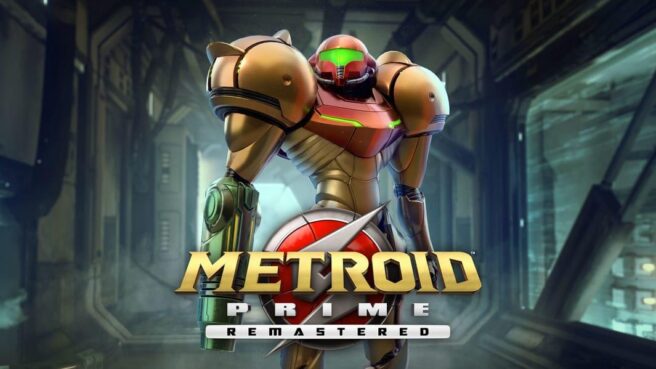
The story in Metroid Prime Remastered wasn’t changed from its original release. It follows Samus Aran as she battles the Space Pirates on the planet Tallon IV.
Metroid Prime Remastered takes what made the original game great and cranked it up to eleven with this remastered entry. There have been so many changes and improvements to this game that I would say it’s more of a remake than a remaster.
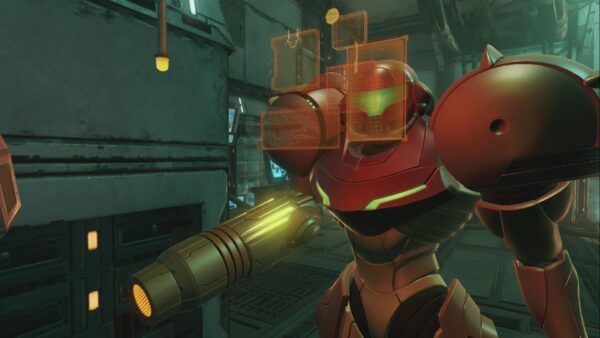
Retro Studios developed the original Metroid Prime in their proprietary RUDE engine back on the GameCube. Now they have come full circle having made this remaster in their latest iteration of the RUDE engine. What this means of course is that this game isn’t just an upscale version of the original that is being emulated, but a stand-alone game built from the ground up in the newest engine. Retro Studios did have some help in bringing this amazing game to the Switch when they sought assistance from Iron Galaxy. Iron Galaxy helped bring such games to the Switch like Skyrim and Diablo III. There were other studios that were brought in as well, but Iron Galaxy seems to be the largest contributor.
With the game being built from the ground up in the latest RUDE engine, it not only allows for a graphical overhaul of the original game, but some additions as well. Featuring brand new textures, brand new lighting system, new music, and improved physics, it feels like a brand new entry into the Prime series. In addition to these improvements in the game’s audio, visual, and mechanical fidelity, the game also features a wide range of new features.
One of the new features is the inclusion of 185 unlockables. These unlockables consist of a soundtrack gallery, a concept gallery, and a character gallery. Items in each of these galleries are unlocked as you progress through the game. The rest of the features included are more to improve upon your experience playing the game rather than extras. Most notable would be the inclusion of narration and the offering of different control schemes.
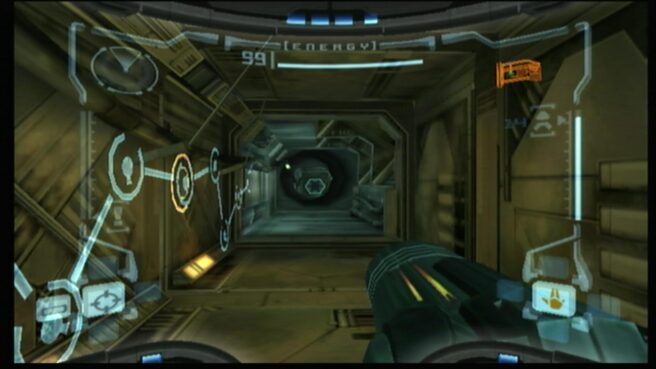
Narration options offered here are partial, full, and of course off. The North American version of Metroid Prime didn’t offer narration but it was offered in both the European and Japanese releases, though even those differed. In the European release of Metroid Prime, only the cinematics were narrated which would be the partial narration option. In the Japanese release, the cinematics and the names of areas were narrated. The inclusion of full narration in the game helps to bring the story to life and I am glad it was included.
The last feature in the options menu to take a look at are the control options. Retro Studios took the controls found in the original Metroid Prime on GameCube and those found in the Metroid Prime Trilogy for the Wii and included them both in this Switch iteration. You have three control schemes to choose from which are dual stick, pointer, hybrid, and classic. The dual stick gives you the modern FPS control scheme with the analog sticks being used to control your movement and your aiming, while the pointer gives you the same control scheme found on the Wii version with the introduction of motion controls that are used for both aiming and camera movement.
The hybrid control scheme is unique to the Switch release providing the motion controls of the Wii version with the dual stick control scheme for a classic control style with immersive aiming. Classic provides you with the same control scheme that started it all with it being what you had with the original Metroid Prime on the Gamecube for those that want a more familiar feeling when it comes to the controls. Beyond these control schemes, there are options included that let you swap buttons and adjust the sensitivity of the analog sticks and motion controls.

Gameplay in Metroid Prime Remastered is unchanged from the original at the core level. But for those coming into this game for the first time, what you will find here is a pretty immersive and sometimes frustrating experience. Primarily played in first-person, there are times when you will play the game in third-person, though these are brief segments. The game takes place on Talan IV which is a vast planet that has a lot to explore, from the planet’s surface to the Chozo Ruins, and beyond. Each area you explore is broken up by doors or hatches that you have to open up by using your basic weapon, special weapon, or ability. You may come across a room with a lot of enemies, a puzzle, environmental hazards to avoid, or a boss battle to fight.
Shortly after arriving on the planet, you will find that the game is pretty linear but then opens up gradually. Certain rooms and doors will require that you have a certain ability or weapon before you can proceed beyond the room, revealing it to be a dead end with you having to find another path to obtain that weapon or ability so that you can come back and get through this room that has halted your progression. Once you obtain all of your weapons and abilities, the planet becomes a vast open playground for you to explore and just admire at times.
Environmental puzzles in the game aren’t too difficult to solve provided that you have the weapon or ability needed to solve them, as they are pretty straightforward. Such as needing the Morph ball ability with the bomb to lower the water level and move platforms with one of the early puzzles you come across. Enemies in the game are plentiful and can either be fought to regain ammo or health, or avoided if you are low on both. Each boss you encounter will have Its own weakness that will either be obvious or one that you will find once you determine its pattern.
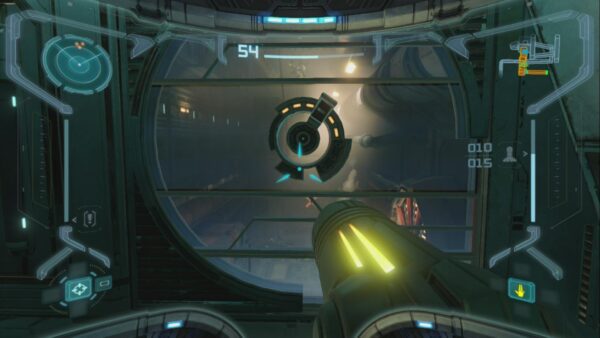
One central mechanic that can really help you is your ability to use your scan visor. This is something that I actually forgot about for a while but makes the game a bit easier. This is because the scan visor can be used to scan enemies, objects in the room you’re in, and even bosses. This will provide you with sometimes crucial and other times helpful information when encountering enemies and bosses. It may give you standard information but also may give you hints as to what it is weak against that can help you turn the tide of battle. Scanning objects in the various rooms can provide you with information on the room itself or may lend a hint as to what needs to be done to get through the specific room you’re in.
As large as the planet is, you do have a radar that helps give you your objective if you have the option turned on and enough time has passed with you roaming aimlessly through already explored areas. There is also a rather detailed 3D Map that is opened up using either the options menu or the dedicated map button. The map is something that you will definitely be continuously consulting to keep tabs on your objective or to help get your bearings on your surroundings. With the tools, weapons, scan visor, and map, the game doesn’t feel like a disjointed and open-world mess. Rather it feels like a methodically detailed and vibrant open-world game that is a lot of fun to play and explore.
Retro Studios really stepped it up with this release. Rather than just updating the visuals to make the game look smoother by today’s standards, they completely overhauled them by adding brand new textures to everything that make the game feel like a brand new entry in the series. The environmental lighting really helps to bring each environment to life and gives the game a sense of realism, like you’re really traversing an alien planet instead of playing a game from the comfort of home. The water looks murky, metal surfaces glint and shine, and the rocks and cliffs have a realistic look to them. Poisonous mushroom spores and clouds of dust that come up when jumping onto or down from a ledge help to add a lot of detailed depth to the game world.
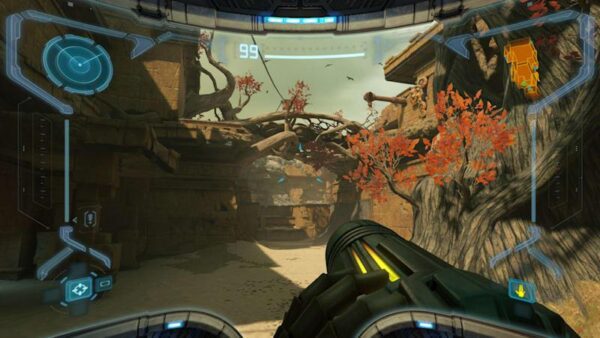
Retro Studios and Iron Galaxy working together to bring this to the Switch made this one of the most seamless generational jumps I have ever seen. So much work went into this game and so much was optimized for the Switch, that it performs flawlessly. Doesn’t matter if you’re playing it in Docked mode or handheld, the game is going to perform beautifully either way. There aren’t any graphical issues, no lag in the controls, and no stuttering in the Gameplay or cinematics. Like I said, this is the most seamless generational jump from the original platform to the Switch that I have ever seen.
The audio in this game is no slouch either. Though the soundtrack in the game has been unchanged from its original, it does sound a bit better than the original game which may in part be just because it’s being played on the Switch as opposed to its original platform. Because of these aspects, it makes the music in the game feel both familiar, yet refreshing. The ambient sounds bring a sense of both dread and life to the game environment. Buzzing or chatter from enemies in the distance, the sound of your footsteps hitting the metal surface, the tunnel you’re in or the distant sound of running water all help to make you aware that the planet isn’t just a beautiful vacation spot, but is also deadly.
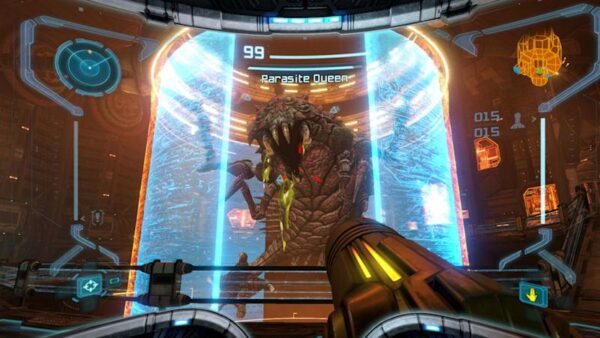
The amount of work and dedication that has gone into Metroid Prime Remastered and the amount of improvements and added elements are the reasons why I truly believe this game is a remake rather than a remaster. A remaster to me would mean that they just updated the visuals to keep the game current with it being on the Switch, but this is much more than that. I feel that enough of the game was altered to call this game more of a remake than a remaster.
Whether you agree that it’s a remake or you believe it to be a remaster, it can’t be argued that this was well worth the wait. If you have played this game back on the Gamecube and are wanting to revisit this game in its new iteration, or are curious about this rejuvenated release in the Metroid franchise, this game is worth picking up and playing either way. There is enough here for fans to recapture the feeling of playing this game for the first time and for those playing for the first time to play this new and exciting entry.
Disclaimer: A review key was provided

